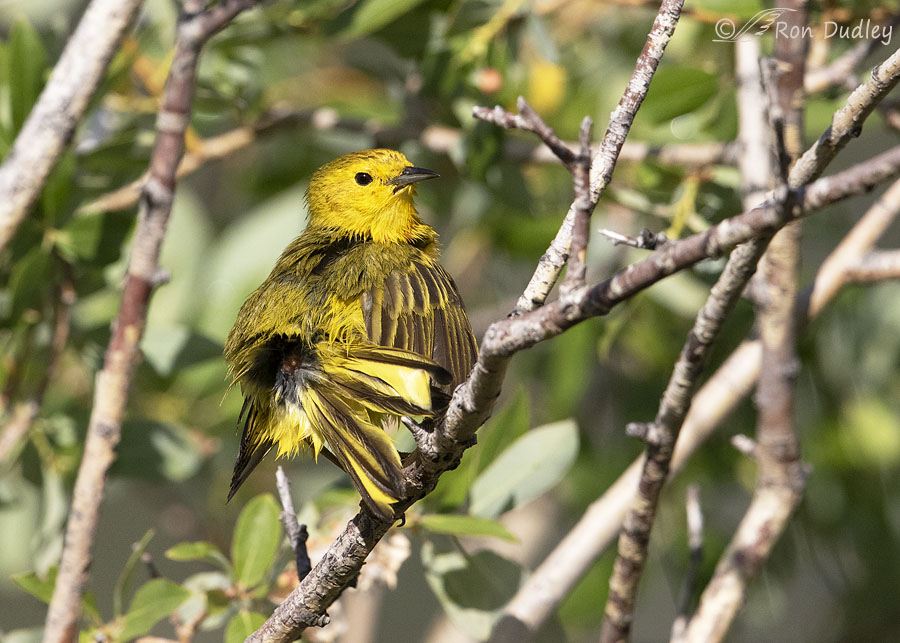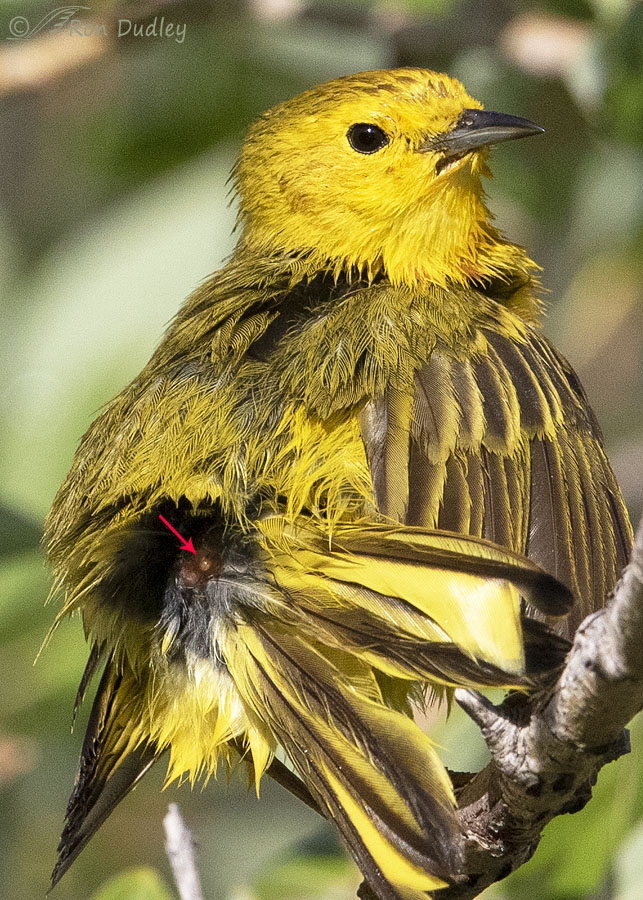Or the preen gland of any songbird for that matter? Well, now’s your chance.
“The uropygial gland, informally known as the preen gland or the oil gland, is a bilobed sebaceous gland possessed by the majority of birds and used to distribute the gland’s oil through the plumage by means of preening. It is located dorsally at the base of the tail and is greatly variable in both shape and size.”
Three days ago in the mountains I took hundreds of photos of a dripping-wet male Yellow Warbler as he was preening after bathing. Yesterday while I was reviewing my photos more carefully I noticed I’d captured something quite unusual in one of them.

1/5000, f/6.3, ISO 800, Canon 7D Mark II, Canon EF 500mm f/4L IS II USM + EF 1.4 III Extender, not baited, set up or called in
During his incredibly frenetic preening activities he raised his rump feathers covering his preen gland to provide him access to its oil which he gets on his beak and face and then smears on his plumage while preening. The fortunate angle I was shooting from allowed me to actually see his preen gland in this photo.
Truth be told my heart skipped a beat when I realized what I’d captured. In my 14 years of photographing birds I’d only documented the preen gland of a bird two times but in each case much larger birds were involved – a Black-crowned Night Heron and a Belted Kingfisher. I’d never before captured the preen gland of a much smaller songbird, especially one as small as a Yellow Warbler.

A huge crop of the same photo allows us a much better look at the nipple (papilla) of the bilobed gland marked with a red arrow.
Lots of things had to come together to get this shot and most of them involved luck. My timing and shooting angle had to be just right during the microsecond he exposed the gland. If the sun hadn’t been low in the sky no light would have reached the gland so all we’d be able to see is a black void beneath the raised feathers. His preening and drying activities were frenetically fast so if I hadn’t had a very high shutter speed all we’d see is a blurry mess. And then I had to notice the gland in my photo. I damn near missed it.
I took 264 photos of this preening warbler in less than 3 minutes and many of them are both interesting and entertaining and every last one of them appears to be sharp so I’m sure I’ll be posting some more of them in then near future.
But I’ll be honest, this is the one that excites me most. I guess that’s the biology teacher in me coming out.
Ron


This biology teacher is pretty excited by this post too. 🙂 Looking forward to seeing the gems you discover in the other 263 photos!
Ron, if you were in CA, I’d give you a major post-pandemic hug! This is an incredibly rare photo, one that so clearly shows the all-important uropygial gland, which I often discuss when helping newer birders. Dan Gleason’s comments are also an elucidative complement to your text. You’re performing such a valuable service for nature lovers, but especially birders. Thank you!
“Ron, if you were in CA, I’d give you a major post-pandemic hug! ”
And if I were in CA I’d take that hug, Nancy!
Dan’s comments are always valuable contributions to my posts. He knows his stuff.
Yet another thing I had never seen – and now, thanks to you, I have.
Thanks Professor. And watching preening birds is a treat anyway – even without this bonus.
A bonus indeed. Thanks, EC.
Seeing a bird preen is one of the things I love most about birdwatching❗️Great catch on a small bird😁
Thank you, Diana.
Gee thank you for the picture and information. Interesting.
You’re welcome, Trudy.
Great capture! It’s a structure the bird uses several times each day yet we seldom have the opportunity to see it. This is a remarkable photo allowing us to see something so vital to a bird’s good health. The gland’s secretions have some antimicrobial properties and other components that help keep feathers in good condition. Well-maintained feathers have a physical structure that can provide water-proofing. The gland oils help feather maintenance but in themselves do not provide the direct water-proofing. Thanks for giving us all this wonderful opportunity to see that which is normally hidden.
Thanks very much, Dan. I figured you might appreciate the uniqueness and value of a photo like this one.
Great shot, you can clearly see the gland.
Thanks, April.
A one in a million shot, except in your case it’s only one in 264. Along with yesterday’s post–and if you continue with these biology lessons–you might have to retitle your blog Professor Dudley’s Feathered Anatomy.😁
Thanks very much, Lyle. There’s probably going to be another “biology lesson” (more like a bird behavior lesson) coming up very soon, this time involving oversexed Spotted Sandpipers.
How very, very interesting. The luck of the well prepared I should think. Thank you for posting shots like this which are so much more than the usual ‘bird on a branch’. Fun, funny 😄 (rump exposed) and even a story to ‘dine out on’ I should think.
“The luck of the well prepared I should think”
Pat, I like to think that’s at least partly true.
In this case I just laid on my shutter and tried to keep my lens pointed in the right direction. If my buffer hadn’t filled up several times I’d probably have taken almost twice as many shots.
Have never seen that gland and most likely never would were it not for your outstanding photo. Great photos and biology lesson. The photos are so sharp and the the colors of the wet feathers are remarkable. Look forward to seeing more of these.
Happy 245th 4th of July to all.
Thanks, Everett. I wasn’t close at all to this warbler so I was very pleasantly surprised by how sharp and how much detail I had in all the photos I took of him.
Nope – only on a chicken. 😉 It IS interesting and certainly unusual to capture it particularly on such a tiny bird! A a bit puzzling that the bird will “mix” oil and water tho chickens certainly aren’t into getting wet dust being more to their liking. Congrats on capturing it. 🙂
“Nope – only on a chicken.”
Made me smile, Judy.
How very interesting! never knew this!
Thanks, Terri.